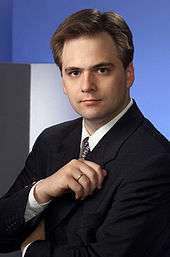Martin Tajmar
Martin Tajmar is a physicist and professor for Space Systems at the Dresden University of Technology.[1] He has research interests in advanced space propulsion systems, FEEP thrusters, breakthrough propulsion physics and possible connections between gravity and superconductivity.[2]

(2010)
Biography
Tajmar completed his PhD in numerical plasmaphysics at the Vienna University of Technology, Austria, in 1999, and is now an external lecturer for the university.[3] He also published the textbook Advanced Space Propulsion Systems in 2003.[4]
Gravitomagnetism research
In a 2003 paper,[5] Tajmar proposed that a gravitational effect may explain the long-standing discrepancy between the mass of Cooper pairs first measured in superconductors by Janet Tate et al. and the theoretically-expected value.
In 2006 Tajmar and several coworkers announced their claim to have measured a gravitomagnetic version of the frame-dragging effect caused by a superconductor with an accelerating or decelerating spin.[2] As of April 2008, the effect has not yet been observed independently.
In February 2008 Tajmar filed an international patent application for a "Process for the generation of a gravitational field and a gravitational field generator."[6]
In June 2008, Tajmar reported a new phenomenon suggesting that signals could be induced in a gyroscope resulting from a new property of rotating low-temperature helium. He also reported that because the rings in the experiment were accelerated pneumatically, and not with high acceleration, the earlier reported results could not be discounted.[7] His further research suggests the anomaly may indeed be coming from liquid helium in the setup.[8]
Awards
- 2001: ARC-Award of the Austrian Research Centers, first prize in the category Science [9]
- 2001 and 2000: “Window on Science” Award[10] of the US Air Force
- 1999: Promotion through the program „International Communication“[11] of the Austrian Research Promotion Agency
References
- portrait_tajmar tu-dresden.de
- Tajmar, M.; Plesescu, F.; Marhold, K. & de Matos, C.J. (2006). "Experimental Detection of the Gravitomagnetic London Moment". arXiv:gr-qc/0603033v1.
Component descriptions and schematics are provided in the following two volumes:
*12. Feb. 2004, dtic.mil: POSSIBLE GRAVITATIONAL ANOMALIES IN QUANTUM MATERIALS. Phase I: Experiment Definition and Design. M. Tajmar and K. Hense
*15. 09. 2005, dtic.mil: POSSIBLE GRAVITATIONAL ANOMALIES IN QUANTUM MATERIALS. Phase II: Experiment Assembly, Qualification and Test Results. M. Tajmar - Home page and biography at the Technical University of Vienna.
- Tajmar, Martin (2002-12-12). Advanced Space Propulsion Systems. ISBN 978-3-211-83862-4.
- Tajmar, M.; de Matos, C.J. (2003). "Coupling of Electromagnetism and Gravitation in the Weak Field Approximation". Physica C. 385 (1, number 4): 551–554. arXiv:gr-qc/0203033. Bibcode:2003PhyC..385..551T. doi:10.1016/S0921-4534(02)02305-5.
- Redaktion. "Patent für Gravitations-Generator angemeldet". derStandard.at. Retrieved 17 December 2015.
- Anomalous Fiber Optic Gyroscope Signals Observed above Spinning Rings at Low Temperature Arxiv.org
- Fiber-Optic-Gyroscope Measurements Close to Rotating Liquid Helium
- Österreichs Wissenschaftspreis „ARC-Award“ pressetext.at, December 2001
- AFOSR: Window on Science (WOS) Archived 2015-09-12 at the Wayback Machine Factsheet
- Internationale Kommunikation Archived 2013-10-29 at the Wayback Machine
External links
- Coupling of Electromagnetism and Gravitation in the Weak Field Approximation: Tajmar, M.; de Matos, C.J. (2001). "Coupling of Electromagnetism and Gravitation in the Weak Field Approximation" (PDF). Journal of Theoretics. 3 (1). Archived from the original (PDF) on 2007-09-28.
- 3 Mar 2000, arxiv.org: Coupling of Gravitation and Electromagnetism in the Weak Field Approximation, M. Tajmar, C. de Matos
- Towards a new test of general relativity?, (Tajmar gravimagnetic field experiment) European Space Agency News, 2006-03-23
- Measurement of Gravitomagnetic and Acceleration Fields Around Rotating Superconductors Tajmar, M.; Plesescu, F.; Seifert, B. & Marhold, K. (2007). "Measurement of Gravitomagnetic and Acceleration Fields Around Rotating Superconductors". AIP Conference Proceedings. 880: 1071–1082. arXiv:gr-qc/0610015v3. Bibcode:2007AIPC..880.1071T. doi:10.1063/1.2437552.
- Gravity's secret, New Scientist, 2006-11-11